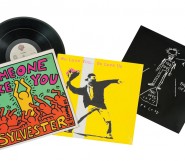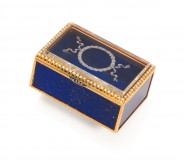Lot #51 - Charles Blackman
-
Auction House:Deutscher and Hackett
-
Sale Name:Important Women Artists + Selected Australian and International Fine Art
-
Sale Date:10 Nov 2021 ~ 7pm (AEDT)
-
Lot #:51
-
Lot Description:Charles Blackman
(1928 - 2018)
Schoolgirl Waving, 1953
oil and tempera on composition board
76.0 x 63.0 cm
signed and dated upper left: Blackman FEBRUARY 53
EXHIBITED: "Paintings and Drawings: Charles Blackman", Peter Bray Gallery, Melbourne, 12 May 1953, cat. 5; "Charles Blackman: The Schoolgirl Years (1951 – 1953), "Tolarno Galleries, Melbourne," "10 June – 2 July 1988, cat. 10 (illus. in exhibition catalogue); "Charles Blackman: A Solitary Existence", Heide Museum of Modern Art, Melbourne, 1 June – 4 July 1993, cat. 13; "Charles Blackman: The Unknowable Divine", Australia Felix: Benalla Easter Arts Festival, various venues in Benalla including the Benalla Art Gallery, Victoria, 15 – 23 April 1995; "Charles Blackman: Schoolgirls", Heide Museum of Modern Art, Melbourne, 4 March – 18 June 2017, cat. 24 (illus. in exhibition catalogue) -
Provenance:Tolarno Galleries, Melbourne; Ivan Durrant, Victoria, acquired from the above in 1988; Savill Galleries, Sydney; Sotheby’s, Melbourne, 23 August 1993, lot 26 (as ‘Schoolgirl’); Private collection, Melbourne
-
References:Morgan, K., (et al.), "Charles Blackman: Schoolgirls", Heide Museum of Modern Art, Melbourne, 2017, cat. 24, p. 70 (illus.); O’Brien, K., ‘Charles Blackman's Schoolgirls at Heide: Visions of innocence cast into darkness’, "Sydney Morning Herald," 28 February 2017
-
Notes:"Fear it has faded in the night"; " The bells all peal the hour of nine."; " Schoolgirls hastening through the light"; " Touch the unknowable divine"1 Powerfully unifying aspects of the artist’s inner emotional world with a unique perspective on contemporary life, Charles Blackman's Schoolgirl paintings represented the first truly sustained sequence of work within his oeuvre and as such, were pivotal in establishing his reputation as an artist of great individuality. Still regarded today among the most iconic series produced in Australia during the immediate post-war years, indeed his surrealist-inflected depictions contrasting the playful innocence of childhood with an underlying sense of menace have become legendary in the public imagination – from their inaugural unveiling at Peter Bray Gallery, Melbourne in 1953 (a classic "succès de scandale") to the more recent exhibition at Heide Museum of Art dedicated solely to exploring further this defining achievement in Australian art, "Charles Blackman: Schoolgirls". As art critic for "The" "Herald", Alan McCulloch, enthusiastically observed in 1953: '...the artist has projected his personality, with all its hopes and frustrations, into the extremely difficult subject of the schoolgirls… [the paintings] speak aggressively, perhaps, but with undeniable power and artistry… In the hands of merely the competent painter such a subject would be ludicrous. In Blackman's hands, John Shaw Neilson's schoolgirl becomes a creature of endless aesthetic possibilities… at once exciting and extremely stimulating.’2 Commenced in 1952 following Blackman's move to Melbourne the previous year, the Schoolgirl series was inspired initially by the reality of the artist's new environment - the neighbourhood of Hawthorn where, travelling to and from his coach-stable studio, uniformed schoolchildren were a daily sight. More profoundly however, the series resonated with his underlying fear of isolation, a fear that was poignantly reawakened by the recent murder of Betty Shanks, a university friend of Barbara’s, in Brisbane in 1952, as well as the notorious murder of a schoolgirl near Melbourne’s Eastern markets some thirty years earlier – ‘the jagged, savage image that childhood is alone’3 having a profound and anguished effect on him. With their tenderness and lyricism, such images also reveal Blackman's insight into the female psyche - a legacy of vivid childhood memories of his mother and sisters that was revived by his reading of the literature of childhood fantasy, particularly French novels of adolescent eroticism such as the Claudine schoolgirl series by Colette. Interestingly, it was not until well after Blackman had embarked upon the theme that he encountered the John Shaw Neilson schoolgirl poetry to which his work is often compared. Admiring especially the semi-blind poet's emotional use of colour, Blackman found the mystical verse 'very akin to what I felt myself in some sort of way... the frailty of their image, as such, and their being a kind of receptacle... of very delicate emotional auras.’4 Featured in both the original Peter Bray exhibition and the recent Heide show, "Schoolgirl Waving", 1953 offers a stunning example of Blackman’s ability to evoke palpable feelings of isolation, vulnerability and the loneliness of childhood. While an irresistible, childlike playfulness and innocence permeates the work in the carefree awkwardness of the schoolgirl’s pose and her shaded eyes peering out tentatively from beneath the school hat, the prevailing mood remains one of uneasy disquiet or foreboding - she is alone and defenceless in an environment that threatens in its darkness, empty of protection, and full of the unknown. Moreover, where other schoolgirls in this hostile urban landscape flee towards some safe destination – the comfort of a streetlight or lamp post - here the protagonist seems blissfully unaware of the danger, perhaps encapsulating the artist’s own inner emotions of vulnerability and nostalgia for an innocence lost that had inspired his identification with the Schoolgirl theme in the first instance: ‘…The Schoolgirl pictures had a lot to do with fear, I think. A lot to do with my isolation as a person and my quite paranoid fears of loneliness and stuff like that; indeed, you could almost say that’s why I painted them.’5 1. Shaw Neilson, J., ‘Schoolgirls Hastening’, "The Bookfellow", Sydney, 30 April 1922; 2. McCulloch, A., ‘Quantity and Quality’, "The Herald", Melbourne, 12 May 1953; 3. Blackman cited in Amadio, N., "Charles Blackman: The Lost Domains", A.H. & A.W. Reed Publishing, Sydney, 1980, p. 14; 4. Blackman in an interview with Thomas Shapcott, 6 September 1966, cited in St John Moore, F., "Charles Blackman: Schoolgirls and Angels", National Gallery of Victoria, Melbourne, 1993, p. 6; 5. Blackman cited in Shapcott, T., "The Art of Charles Blackman", Andre Deutsch, London, 1989, p. 11 VERONICA ANGELATOS
-
Estimate:A$140,000 - 180,000
-
Realised Price:
-
Category:Art
This Sale has been held and this item is no longer available. Details are provided for information purposes only.










